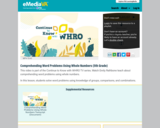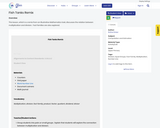
Exploring Equal Shares Through Division and Multiplication Strategies - Rich Mathematical Task Template and Student Version
- Subject:
- Mathematics
- Material Type:
- Lesson Plan
- Provider:
- VDOE
- Author:
- VDOE
- Date Added:
- 10/07/2024

Exploring Equal Shares Through Division and Multiplication Strategies - Rich Mathematical Task Template and Student Version

Sharing: Division Statements and Fractions Mathematics Instructional Plan

Pears in a Basket: Dividing with Whole Numbers Mathematics Instructional Plan

Trip Transportation Task Template and Student Version of Task

Explore the importance of remainders in a division problem - Algebra Readiness Remediation Plan

Solving practical problems using the four basic operations with whole numbers - Mathematics Instructional Plan

Fraction Computation Algebra Readiness Formative Assessment

Divide Fractions and Mixed Numbers Mathematics Instructional Plan

Modeling Division of Fractions Mathematics Instructional Plan

Cookie Topping Task Template, Student Version of Task, Anchor Pages and Scoring Rationale

Operations with Integers Division Algebra Readiness Remediation Plan

Students will analyze a provided math problem with an incorrect answer (bug). Students will demonstrate their understanding of the process by identifying the error, solving the problem correctly and providing an explanation. Math problem solving directly correlates with the step by step process that computer science debugging requires. The purpose of this experience is to provide a jumping off point for a deeper understanding of the Computer Science SOLs. This could be the first time your students are exposed to the vocabulary (algorithm, bug, debugging) and can provide a good foundation of the understanding of the vocabulary in a concrete, low-technology way.

This video is part of the Continue to Know with WHRO TV series. Watch Emily Rathbone teach about comprehending word problems using whole numbers.

This video is part of the Continue to Know with WHRO TV series. Watch Emily Rathbone teach about estimating and solving multistep word problems using whole numbers.

This lesson, which is a remix from an Illustrative Mathematics task, discusses the relation between multiplication and division. Fact families are also explored.https://goopenva.org/courses/3-oa-fish-tanks

This video is part of the Continue to Know with WHRO TV series. Watch Kyle Snyder teach about how fractions are actually division problems.

Unit 2 opens students’ eyes to some of the most important content students will learn in Grade 3—multiplication and division. In this unit, “students begin developing these concepts by working with numbers with which they are more familiar, such as 2s, 5s, and 10s, in addition to numbers that are easily skip counted, such as 3s and 4s,” allowing the cognitive demand to be on the concepts of multiplication and division themselves rather than the numbers (CCSS Toolbox, Sequenced Units for the Common Core State Standards in Mathematics Grade 3). Then in Unit 3, students will work on the more challenging units of 0, 1, 6–9, and multiples of 10.
In Grade 2, students learned to count objects in arrays using repeated addition (2.OA.4) to gain a foundation to multiplication. They’ve also done extensive work on one- and two-step word problems involving addition and subtraction, having mastered all of the problem types that involve those operations (2.OA.1). Thus, students have developed a strong problem-solving disposition and have the foundational content necessary to launch right into multiplication and division in this unit.
At the start of this unit, students gain an understanding of multiplication and division in the context of equal group and array problems in Topic A. To keep the focus on the conceptual understanding of multiplication and division (3.OA.1, 3.OA.2), Topic A does not discuss specific strategies to solve, and thus students may count all objects (a Level 1 strategy) or remember their skip-counting and repeated addition (Level 2 strategies) from Grade 2 to find the product. In Topics B and C, however, the focus turns to developing more efficient strategies for solving multiplication and division, including skip-counting and repeated addition (Level 2 strategies) as well as “just knowing” the facts, which works toward the goal that “by the end of grade 3, [students] know from memory all products of two single-digit numbers and related division facts” (3.OA.7). As the Operations and Algebraic Thinking Progression states, “mastering this material and reaching fluency in single-digit multiplications and related division may be quite time consuming because there are no general strategies for multiplying or dividing all single-digit numbers as there are for addition or subtraction” (OA Progression, p. 22). Thus, because “there are many patterns and strategies dependent upon specific numbers,” they first work with factors of 2, 5, and 10 in Topic B, since they learned these skip-counting sequences in Grade 2. Then in Topic C, they work with the new factors of 3 and 4. Only then, when students have developed more familiarity with these factors, will students solve more complex and/or abstract problems with them, including determining the unknown whole number in a multiplication or division equation relating three whole numbers (3.OA.4) and solving two-step word problems using all four operations (3.OA.3, 3.OA.8), assessing the reasonableness of their answers for a variety of problem types in Topic D.
Throughout the unit, students engage in a variety of mathematical practices. The unit pays particular attention to reasoning abstractly and quantitatively, as students come to understand the meaning of multiplication and division and the abstract symbols used to represent them (MP.2). Further, students model with mathematics with these new operations, solving one- and two-step equations using them (MP.4).

Unit 3 extends the study of factors from 2, 3, 4, 5, and 10, which students explored in Unit 2, to include all units from 0 to 10, as well as multiples of 10 within 100. To work with these more challenging units, students will rely on skip-counting (a Level 2 strategy) and converting to an easier problem (a Level 3 strategy dependent on the properties of operations). They then will apply their understanding of all four operations to two-step word problems as well as arithmetic patterns. Finally, the unit culminates with a focus on categorical data, where students draw and solve problems involving scaled picture graphs and scaled bar graphs, a nice application of the major work of multiplication and division.
Topic A begins by reminding students of the commutative property they learned in Unit 2, as well as introducing them to the distributive and associative properties, upon which they will rely for many of the strategies they learn for the larger factors. In order to be able to use these properties, they need to understand how to compute with a factor of 1, which they explore along with 0, as well as understand how to use parentheses. They’ll then explore the factors of 6, 7, 8, and 9 in Topics B and C. Because of the increased difficulty of these facts, students will rely on both skip-counting (a Level 2 strategy) as well as converting to an easier problem (a Level 3 strategy). Converting to an easier problem is dependent on the properties of operations (e.g., to find 6 x 7, think of 5 x 7 and add a group of 7 is dependent on the distributive property). Thus, students will work with the properties extensively throughout the unit, with their understanding of them and notation related to them growing more complex and abstract throughout the unit. In Topic D, students will multiply one-digit numbers by multiples of 10 and by two-digit numbers using the associative property. Then, students solve two-step word problems involving all four operations, assessing the reasonableness of their answer, and identify arithmetic patterns and explain them using the properties of operations. Finally, students explore picture graphs in which each picture represents more than one object and bar graphs where the scale on the axis is more than 1, a key development from Grade 2 (3.MD.3). As the Progressions note, “these developments connect with the emphasis on multiplication in this grade” (MD Progression, p. 7). Students also solve one- and two-step word problems related to the data in these plots, relying on the extensive work students have done with word problems throughout the year. Thus, this supporting cluster standard nicely enhances the major work they’ve been working on throughout this and the previous unit.
In Unit 3, students deepen their understanding of multiplication and division, including their properties. “Mathematically proficient students at the elementary grades use structures such as…the properties of operations…to solve problems” (MP.7) (Standards for Mathematical Practice: Commentary and Elaborations for K–5, p. 9). Students use the properties of operations to convert computations to an easier problem (a Level 3 strategy), as well as construct and critique the reasoning of others regarding the properties of operations (MP.3). Lastly, students model with mathematics with these new operations, solving one- and two-step equations using them (MP.4).

In this unit, students explore the concept of multi-digit division and its applications, such as interpreting a remainder in division word problems and using division to determine the nth term in a repeating shape pattern.
Students developed a foundational understanding of division in Grade 3, when they came to understand division in relation to equal groups, arrays, and area. They developed a variety of strategies to build towards fluency with division within 100, and they applied that knowledge to the context of one- and two-step problems using the four operations. Students also came to understand the distributive property, which underpins the standard algorithm for division.
Just as at the beginning of the previous unit when students expanded their understanding of multiplication beyond Grade 3 understanding to include multiplicative comparison word problems, this unit starts off with the added complexity of division problems with remainders (4.OA.3). This is likely familiar to students from their own real-world experiences of trying to split quantities evenly, and thus the focus is on interpretation of those remainders in the context of various problems. Next, students focus on extending their procedural skill with division to include up to four-digit dividends with one-digit divisors (4.NBT.6), representing these cases with base ten blocks, the area model, partial quotients, and finally the standard algorithm, making connections between all representations as they go. The use of the area model serves to help students conceptually understand division, and as a connection to their work with area and perimeter (4.MD.3), a supporting cluster standard. Lastly, armed with a deep understanding of all four operations spanned over the last three units, students solve multi-step problems involving addition, subtraction, multiplication, and division, including their new problem situations such as multiplicative comparison and interpreting remainders (4.OA.3). They also explore number and shape patterns, using the four operations to draw conclusions about them (4.OA.5).
Throughout the unit, students are engaging with the mathematical practices in various ways. For example, students are seeing and making use of structure (MP.7) as they “decompos[e] the dividend into like base-ten units and find the quotient unit by unit” (NBT Progressions, p. 16). Further, "by reasoning repeatedly (MP.8) about the connection between math drawings and written numerical work, students can come to see multiplication and division algorithms as abbreviations or summaries of their reasoning about quantities” (NBT Progression, p. 14). Lastly, as students solve multi-step word problems involving addition, subtraction, and multiplication, they are modeling with mathematics (MP.4).
While students are encouraged throughout the unit to use models when appropriate to solve problems, their in-depth experience with the place value system and multiple conceptual models and exposure to the division algorithms prepares them for extending these models to two-digit divisors in Grade 5 (5.NBT.6) and to fluency with the division algorithm in Grade 6 (6.NS.2). Every subsequent grade level depends on the understanding of multi-digit division and its algorithms, making this unit an important one for students in Grade 4.

Just in Time Quick Check Estimate and Determine Quotients